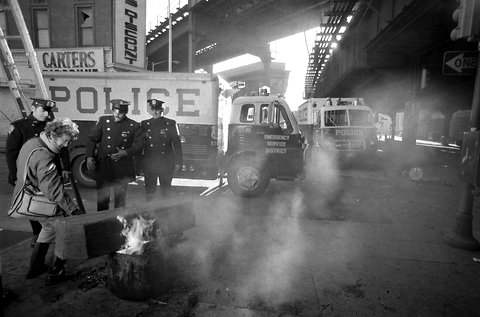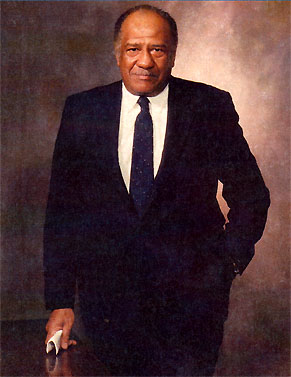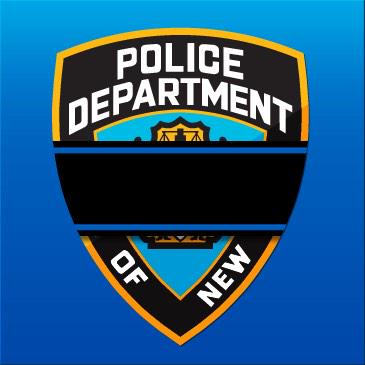|
Myrtle Avenue. Even before Saturday, the name made me hear the terrible sound of police knuckles against steel lockers in the back room of the station house, the curses and the cries and the helplessness.
That memory is from the dark days of January of 1973, when a police officer was killed on duty under bisecting elevated trains at the intersection of Myrtle and Broadway in the Bushwick neighborhood. Last Saturday it happened again, four blocks away at the corner of Tompkins and Myrtle, in adjacent Bedford-Stuyvesant. Two officers were assassinated as they sat in their car. It never ends. In 1973, Officer Stephen R. Gilroy was killed during a botched robbery at a sporting goods store, when four young men, caught up in an American Black Muslim rivalry, had tried to arm themselves. For two days, the Bushwick neighborhood was shut down, power to the El cut off. But no more shots were fired because one of the great cops of New York, Deputy Commissioner Benjamin Ward, used modern siege tactics to wait out the men inside. At 1 o’clock on a Sunday afternoon, promised they would not be gunned down, the men surrendered. As part of the huge Times contingent that weekend, I was posted at the station house when three of the men (one went to the hospital) were booked, as officers pounded their lockers in frustration. I also covered Stephen Gilroy’s funeral a few days later. To this day, I cannot hear bagpipes without thinking of the family coming out of the handsome old church in Brooklyn. This year Americans have learned about senseless deaths in Ferguson, Mo., and Staten Island. I’ve read the stories, seen the videos, heard the interviews, parsed the testimony, second-guessed the grand jury work. My conclusion is that the tactics that Benjamin Ward espoused – patience, logic, fairness, rules, and, yes, toughness – would have kept Michael Brown and Eric Garner very much alive. Benjamin Ward later became New York's first African-American police commissioner. I thought of him this summer when I visited the intersection of Myrtle and Broadway. Somebody is doing a reprise of the siege, and I was dredging up my memories, as one of the younger reporters on the scene that sad weekend. In late August young (white) people were clumping down the steep staircase from the El, lugging roller suitcases, moving into Bushwick, to rehabbed houses on side streets. I had lunch in a hipster place where they served crispy kale. The sporting goods store is now a peluqueria – a hair salon. All 12 chairs were busy on a summer Saturday morning. Life was going on. In the wake of Brown and Garner and other needless deaths, most protests have been peaceful, as if people had heard of Gandhi and King and John Lewis, but on the nearby Brooklyn Bridge somebody threw a garbage can at police and others jumped cops who were keeping the peace. All I know is, Violence begets violence.
Thor A. Larsen
12/22/2014 02:48:07 am
Thank you George, for your fine article tying the police killing tragedy of 1973 to these recent police tragedies, As you noted, there were many lessons of 1973 that applies to 2014. One lesson, seems to me, is that if a senior oficial such as Mayor DeBlasio or for that matter, President Obama, chooses to use personal experiences as a guide for modification of police behavior, it is NOT a pervasive condemnation of police behavior as portrait by the 'rabble rousers' and some of the press. Unfortunately, the modern media, TV etc, have ramped up the hysteria and were culprits in some of the violence and contributors to the latest tragedy. Now, I would also think that more people will realize the incredible danger that the police are facing daily and why they appear to be too aggressive at times. Another underlying problem is the prevalence of GUNS! If the country established very strict gun laws as they have in most countries in Europe there would be significantly fewer tragedies as we witness the other day. The source of the gun provided to the police killer should be tracked down, and convicted for at least manslaughter.
George Vecsey
12/22/2014 05:47:55 am
Thor, that's the first thing we said, more guns, more guns.
Brian Savin
12/22/2014 02:25:40 pm
Yes, George, the wheel spins around and around, repeating a bleak history and making no progress. As you seem to say, we can't imply any rationality to murderous behavior. So, what are we left with? Yelling "stop" to the murder, bemoaning the lack of adequate treatment for the criminally sick? We need to do...something. But if the Mayor of the City and the Police Force brass and most rank and file are not on the same page, then we are not even at the start of making any useful progress for community good. When the police union circulates a letter that enables officers to express their desire that the Mayor not be invited to their funeral if they are killed in the line of duty, then we are closer to hopeless than hopeful. Able intelligent leadership is a very, very hard thing to come by these days.
George Vecsey
12/23/2014 01:19:52 am
Brian, round and round, indeed. I'm a union guy and have great respect for the police from having gone around with some on stories in the 70's. Union rhetoric is something else. Some things never change. Benj. Ward had to hold off urging to storm the store in 1973. Modern negotiating tactics had not filtered down to the ranks. On it goes. GV. Comments are closed.
|
Categories
All
|












